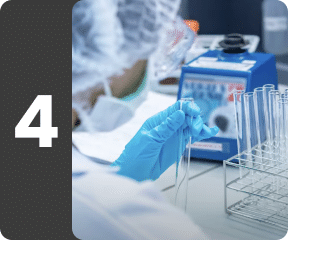

Polycystic Ovarian Disease Panel With Smart Report near me in Gurgaon
Understanding Polycystic Ovarian Disease Panel With Smart Report in Gurgaon
What is Polycystic Ovarian Disease Panel With Smart Report in Gurgaon?
Polycystic Ovarian Disease Panel (PCOS Panel) with Smart Report helps detect polycystic ovarian syndrome (PCOS) in women, a hormonal disorder that leads to multiple cysts in the ovaries. The common symptoms of PCOS in women include irregular periods, weight gain, and excess body hair. This package offers a series of tests to determine your hormone levels, such as a luteinizing hormone (LH) test, testosterone (total) test, thyroid stimulating hormone (ultrasensitive) test, follicle-stimulating hormone (FSH) test, LH to FSH ratio, prolactin test, insulin (fasting) and glucose (fasting) test.
Avail this package with an interactive, easy-to-understand smart health report. This report uses pictures and infographics to simplify complex medical parameters and enables a better understanding of the test results.
What does Polycystic Ovarian Disease Panel With Smart Report measure?
Contains 8 tests
Luteinising Hormone
Luteinizing hormone is associated with reproduction and ovulation. In females, it stimulates the release of an egg from the ovary. However, in males, testosterone production is dependent on LH. This test helps in measuring the amount of LH present in the blood.
LH is produced by the pituitary gland, and its production is controlled by the hypothalamus, pituitary gland, and the hormones produced by the ovaries (in women) or testicles (in men).
In premenopausal women, LH stimulates ovulation and the production of other hormones, estradiol, and progesterone. The menstrual cycle is divided into 2 phases, follicular and luteal phases, each of these last for about 14 days. Near the end of the follicular phase, there is a mid-cycle increase in follicle-stimulating hormone (FSH) and LH. This triggers ovulation. During the luteal phase, LH secretion stimulates the corpus luteum to start producing progesterone. At this point, FSH and LH levels get reduced, while progesterone and estradiol concentrations rise. If the egg is not fertilized, then the levels of these hormones fall after several days followed by the beginning of the next menstrual cycle. With the onset of menopause ovarian function reduces and eventually discontinues, which results in increased levels of FSH and LH.
In men, LH stimulates Leydig cells in the testicles to produce testosterone. However, LH levels remain relatively constant in men after puberty. A high testosterone level provides negative feedback to the pituitary gland and the hypothalamus, thus decreasing the amount of LH secreted.
In infants and children, LH levels rise shortly after birth and then fall to very low levels (by 6 months in boys and 1-2 years in girls). At about 6-8 years of age, levels again rise before the beginning of puberty and secondary sexual characteristics development.
Know more about Luteinising Hormone

Follicle Stimulating Hormone
Follicle-stimulating hormone (FSH) is a hormone which is associated with reproduction and the development of eggs in women and sperm in men. This test measures FSH in the blood.
FSH is produced by the pituitary gland, and its production is controlled by a feedback system involving the hypothalamus in the brain, the pituitary gland, and the hormones produced by the ovaries or testicles. The Gonadotropin-releasing hormone (GnRH) from the hypothalamus stimulates the pituitary gland to release FSH and luteinizing hormone (LH; another closely-related hormone also involved in reproduction). FSH affects the growth and maturation of egg follicles in the ovaries during the follicular phase of the menstrual cycle. The menstrual cycle is divided into follicular and luteal phases, each phase lasting for 14 days. During the follicular phase, FSH initiates the production of estradiol by the follicle, and the two hormones work together in the further development of the egg follicle. Near the end of the follicular phase, the production of FSH and luteinizing hormone increases. The release of the egg from the ovary (ovulation) occurs shortly after this increased production of hormones. The hormone inhibin as well as estradiol and progesterone help control the amount of FSH released by the pituitary gland. FSH also facilitates the ability of the ovary to respond to LH. At menopause, ovarian function decreases and eventually ceases which results in increased levels of FSH and LH.
In males, the role of FSH is to stimulate the testicles to produce mature sperms and also promotes the production of androgen binding proteins. FSH levels are relatively constant in men after puberty than in women.
In infants and children, FSH levels rise shortly after birth and then fall to very low levels by 6 months in boys and 1-2 years in girls. Concentrations begin to rise again before the beginning of puberty and the development of secondary sexual characteristics.
Disorders affecting the hypothalamus, pituitary, and/or the ovaries or testicles can cause the production of too much or too little FSH, resulting in a variety of conditions such as infertility, abnormal menstrual cycles, or early (precocious) or delayed sexual maturation (puberty).
Know more about Follicle Stimulating Hormone

Insulin - Fasting
Carbohydrates consumed in the diet are digested and converted into the simple sugar, glucose. Glucose is absorbed by the cells for the production of energy, or stored in other forms like fats. Insulin is the hormone responsible for the uptake of glucose by the cells from blood for utilization and storage. It thus helps to maintain blood glucose levels within a normal range. Insulin also plays an essential role in the metabolism of lipids.
Levels of blood glucose and levels of insulin in blood maintain a balance with each other. A rise in blood sugar stimulates insulin production by the pancreas. This causes insulin levels to rise in blood. Insulin stimulates the uptake of glucose by cells, leading to a fall in blood glucose, and insulin levels in turn. Disruptions in this mechanism due to low insulin production by pancreas or inability of cells to respond to insulin (insulin resistance) cause a rise in blood sugar levels or hyperglycemia. Hyperglycemia is associated with diabetes. Diabetes Type 1 is an inherited condition where insulin is produced in insufficient quantities. Diabetes Type 2 occurs due to insufficient insulin production, or due to the development of insulin resistance. When cells are unable to respond to insulin, they cannot take up glucose from the blood effectively. The cells are deprived of glucose for energy, while glucose levels become high in the blood.
Insulin resistance increases with time. Increased glucose levels in blood stimulate the pancreas to produce excess insulin, leading to hyperinsulinemia (high insulin levels in the blood) along with hyperglycemia. Insulin resistance can also be seen in cases other than diabetes, such as prediabetes, polycystic ovarian syndrome (PCOS), pituitary or adrenal gland diseases, etc.
High insulin levels in the blood may also occur in patients suffering from tumors in the beta cells of pancreatic glands, or in cases of insulin overdose. Since excess insulin in these cases is not caused due to excess blood sugar levels, hyperinsulinemia in these cases can cause hypoglycemia (low blood sugar), leading to energy deprivation in all cells of the body.
Know more about Insulin - Fasting

Testosterone Total
Testosterone is a sex hormone which is mainly found in men. It can also be found in women but in small amounts. The appearance of male physical characteristics is due to testosterone hormone. Testosterone Total measures the levels of testosterone in the blood.
In men, testosterone is produced by the Leydig cells present in the testicles. It is also produced by the adrenal glands in both males and females. In females, small amounts of testosterone are produced by the ovaries.
The function of testosterone is to develop secondary sex characteristics which include enlargement of the penis, body hair growth, development of muscle, and deepening of the voice. During puberty, it is produced in large amounts in males. In adult males, its function is to regulate the sex drive and to maintain muscle mass. In adult females, the testosterone gets converted to estradiol, which is the main sex hormone in females.
The testosterone hormone production is regulated by luteinizing hormone (LH), which is produced by the pituitary gland. As the levels of testosterone rise, the production of LH decreases which in turn slows down the production of testosterone. Similarly, when the levels of testosterone fall, it leads to an increase in production of LH which stimulates testosterone production.
The levels of testosterone are highest in the early morning and lowest in the evening. With exercise, the levels of testosterone increase and with age the levels decrease.
In the blood, about two-thirds of testosterone hormone is bound to sex-hormone binding globulin (SHBG) and about one-third is bound to albumin. A small amount is present as free testosterone.
Know more about Testosterone Total
LH FSH Ratio
Prolactin

Glucose - Fasting
Glucose - Fasting Blood Test is done to measure the levels of glucose in blood during period of fasting.
Glucose is the main source of energy for body. Carbohydrates consumed in the diet are broken down in the body to glucose, which is absorbed by the intestines and transported by the blood to various organs. The cells of these organs utilize the glucose to produce energy when required, and the excess is stored either as glycogen in the liver for short-term storage or in fat tissues as triglycerides for long-term storage. The uptake, utilization, and storage of glucose after it is absorbed in the intestines is facilitated by the hormone- insulin which is secreted by the pancreas. Insulin influences the transport of glucose to the organs like heart, brain, working muscles, etc. It also directs storage of excess glucose. The action of insulin reduces sugar levels in the blood.
After a meal, sugar levels increase in blood and insulin is secreted in response to reduce sugar levels until it becomes normal. If glucose levels fall too low in blood, another pancreatic hormone called glucagon is released, which directs the liver to convert stored glycogen into glucose and releases it into the blood. The insulin and glucagon hormones create a feedback mechanism to keep blood glucose levels within the normal range. Imbalance in their activity causes an excess or shortage of blood sugar.
Glucose - Fasting blood Test helps to determine if the body is able to utilize or store glucose efficiently. High levels of sugar in blood indicates diabetes or resistance to insulin. Type 1 Diabetes is caused when insulin is not produced or produced in very little quantity. Type 2 Diabetes is caused when insulin produced is not utilized effectively by the body. In both these cases, blood sugar level rises, while cells are deprived of nutrition.
Know more about Glucose - Fasting

Thyroid Stimulating Hormone, Ultrasensitive
Thyroid Stimulating Hormone (TSH) test measures the amount of TSH in your blood which helps to find out if the thyroid gland is working normally or not. Low TSH levels indicate hyperthyroidism and high TSH levels indicate hypothyroidism.
In case of hyperthyroidism, the thyroid gland produces very high amounts of thyroid hormones (T3 and T4) and you may experience symptoms of weight loss, rapid heartbeat, tremors, sweating, anxiety, increased sensitivity towards heat, etc. In case of Hypothyroidism, there is a decrease in the production of thyroid hormones (T3 and T4) which may cause weight gain, fatigue, slow heart rate, increased sensitivity towards cold, depression, dry and thin hair, etc.
There is a feedback system in the body to maintain stable amounts of the thyroid hormones (T3 and T4) in the blood. TSH signals the thyroid gland to make and release the thyroid hormones (T3 & T4) into the blood when the level of thyroid hormones is low and can also signal the thyroid gland to lower the production of thyroid hormones when the level of thyroid hormones is very high. So, when the thyroid hormone (T3 and T4) levels decrease, the pituitary gland is stimulated to release TSH and this high TSH level, in turn, stimulates thyroid gland to release more thyroid hormone (T3 & T4) from the thyroid gland and the vice-versa happens when the thyroid hormone levels are very high.
Know more about Thyroid Stimulating Hormone, Ultrasensitive
Book a Polycystic Ovarian Disease Panel With Smart Report test at home near me





Other tests










